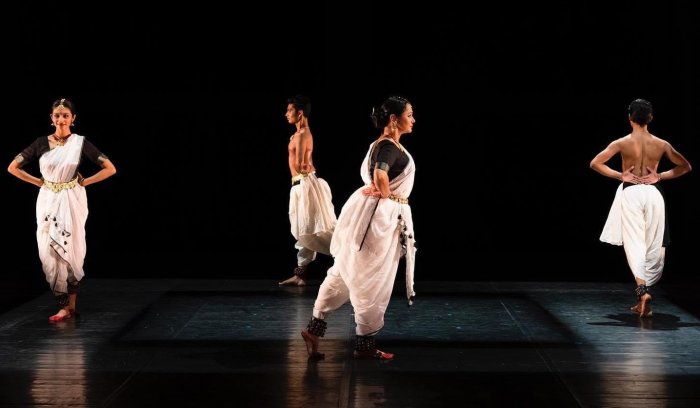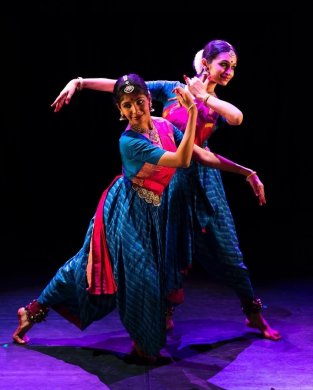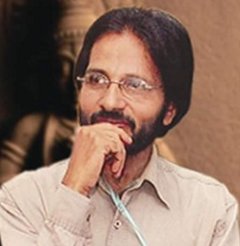
|   |

|   |
Geometry, Sensuality and the Spiritual Quest - V. Kaladharan e-mail: kaladh@rediffmail.com Photos: Innee Singh January 22, 2022 Bharatanatyam, with its intimidating popularity, has, over the years, compelled most of its practitioners to go in for experimentations mainly to reinforce their presence or to reaffirm their identities in the field. But there are a few renowned dancers whose passion for experimentations/explorations does carry an organic trait. One among them is undoubtedly Rama Vaidyanathan for whom each recital is an opportunity for the subtle reinterpretation of tradition, self-renewal and introspection. Recently she did an online recital in which the language of Bharatanatyam was turned into a compelling medium to highlight the geometric and aesthetic grace of square, triangle and the circle. The group choreography has proved to be the resultant of the dancer's imaginative proficiency, relentless homework and an eye for detail.  Chaturasra Pada Rama and her co-dancers begin their performance with an Alarippu in Ata tala titled as Chaturasra Pada, the quadrangle of precision. At the very outset they position themselves to form a square and the refrain, Kit ta thaka thom thi thom thai tha thai, empowers the dancers' movement dynamics. The dancers effortlessly create the architectonic ambience of a temple with its essential ingredients viz. fire, Yaga, flag mast and procession. The vertical and horizontal movements of the dancers display an astounding symmetry and their intermittent return to the 'square' becomes a delightful aesthetic treat.  Yoni Tantra In the succeeding item Yoni Tantra, Devi Kamakhya, the goddess of desire embodying the Tantric worship, comes to the fore. She is sage Bharata's muse and her triangle shaped vulva is eulogized as the abode of fertility and power. Her womb is exalted as the most sacred space in the Universe. The Sanskrit verse is taken from Kamakhya Tantram. The line, Sreekaamakhyam Yoniroopa is evocatively sung by the incredibly gifted vocalist Sudha Raghuraman and forcefully portrayed by the talented dancers. The triangle formulated by the agile dancers on stage spontaneously merges with the meaning of the verse. The permutation of the angikaabhinaya is aesthetically nuanced and awe inspiring. The dhyana shloka followed by Deekshitar's "Sringara rasamanjari! Sreekamakshi Gowri" is visualized in all its momentousness. The vocal music, with its unbelievable clarity, almost borders the Vedic chanting and the vilamba kaala attributes a meditative quality to the dance. To concretize the abstract concept of the Kundalini joining the Sahasraara padma in stylized hand gestures, body movements and expressions is easier said than done. Unlike most of her colleagues in the field of Bharatanatyam, Rama has an insatiable urge to give expression to the 'impossible'. In the present choreography too her profound craving to distinguish her creations with a philosophical undertone is eminently visible. Towards the finale of the item, the dancers lie down forming a triangle that highlights once again its central concern. Yoni Tantra is soaked in sensuality from the beginning till the very end. Yet it is seldom loud. As the dance progresses, an aura of devotion/spirituality envelops the sensuality.  Raas Mandala In the concluding piece, Rama and her team of dancers perform Raas Mandala, the circle of passion. The circle stands for eternity and timelessness. Compared to the above two, the viewers are witness to the familiar images of Lord Krishna and the Gopikas and their raasa leela. The diversity and finesse of the lasya laden movement techniques are simply fabulous. Although a relatively free-wheeling item, it is deceptively simple. A discerning mind can easily recognize the choreographic dexterity that has gone into each and every frame. Plain notes characterize the vocal music and the pallavi, "Muralee naad sunaayo" is enriched with bhava evocative jathis. Multiple shades of the rasa, Sringara, enliven the item anchored on 'circle' representing and reinforcing the continuity of the spirit of life and the cosmos. The Sanskrit verse in the item is borrowed from Sreemad Bhagawatham followed by the alluring Bhajan of Surdas in ragamalika. Apart from the commendable support of the background artists, the success of the recital has a lot to do with Deepa Dharmadhikari's light design and Innee Singh's filming and editing. Both of them have contributed substantially to further the tone and texture of the dance. Just out of curiosity I asked Rama what prompted her to undertake the choreography of the items above. Pat came her reply. "As a school student, I was always fascinated with geometry and this percolated into the dance studio. While dancing I felt I was carving geometry in space. My study of Indian philosophy and my deep interest in integrating my dance with geometry and spirituality lead me to create 'Sannidhanam' - sacred spaces. I created it during the lockdown, specially, for Jai Govinda and Mandala Arts who commissioned it." Mandala Arts and Culture in collaboration with the Dance Centre Vancouver, presented Sannidhanam.  Former Deputy Registrar of Kerala Kalamandalam, V Kaladharan is also an art critic. He has published several articles at the academic level. 'From Meditative Learning to Impersonal Pedagogy' was published a couple of years back in an anthology 'Qui Parley' initiated and released by scholars and writers from the University of California, Berkeley. His articles on Indian performing arts and literature regularly appear in magazines and journals, and in the Friday Page of The Hindu. |